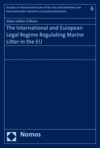Zusammenfassung
Jährlich gelangen mehr als 6 Millionen Tonnen Abfall in unsere Meere. Aus der Langlebigkeit der eingetragenen Stoffe sowie deren ökologischen und toxischen Auswirkungen ergeben sich besondere Herausforderungen an unsere Gesellschaft. Vor diesem Hintergrund, untersucht und erarbeitet die Autorin Lösungsstrategien zur Vermeidung von Meeresmüll in den vier Europäischen Meeren. Dabei werden sowohl völkerrechtliche sowie Rechtsinstrumente der Europäischen Union auf ihre Regulierungsstrategien untersucht und Regulierungslücken identifiziert. In einer interdisziplinären Herangehensweise, deckt die Autorin Meeresmüllquellen wie Schifffahrt oder Abfallmanagement ab und erarbeitet somit die erste Monographie, die die Gesamtheit von regulativen Meeresmüllvermeidungsstrategien in der Europäischen Union betrachtet.
Abstract
Each year approximately 6.4 million tons of waste reach our oceans. The consequences of this pollutant are manifold and encompass environmental, economic and potentially also human health impacts. The book is the first monography to address regulatory responses to marine litter in a comprehensive way. The author analyses the applicable regulatory instruments addressing the introduction of marine litter and identifies gaps and loopholes in the regulatory systems of international and European law applicable to the four seas surrounding the European Union. Based on a factual discussion of the sources and impacts of marine litter, these instruments are systematically studied and reflected with a view to their effectiveness to prevent its introduction. Marine litter stands symbolic for the use of resources and the findings of the monography can be used as recommendations to address this issue.
- Kapitel Ausklappen | EinklappenSeiten
- 19–28 Introduction 19–28
- 93–124 C. UNCLOS 93–124
- 160–164 E. Conclusion 160–164
- 237–245 F. Regional Action Plans 237–245
- 391–407 Conclusion and Summary 391–407
- 407–454 Bibliography 407–454

